Better Cancer Care, An Action Plan
Better Cancer Care, An Action Plan outlines the way forward for cancer services, which are required to support all those in Scotland who find themselves living with and beyond cancer.
SECTION ONE: THE CHALLENGE FOR SCOTLAND
Cancer Incidence
Every year, about 27,000 people in Scotland are told that they have cancer. Lung, prostate and large bowel cancers account for approximately 53% of all cancers in men (Figure 1) whilst breast, lung and large bowel cancers account for 55% of all cancers in women (Figure 2).
Figure 1: The most frequently diagnosed malignancies in men in Scotland in 2005
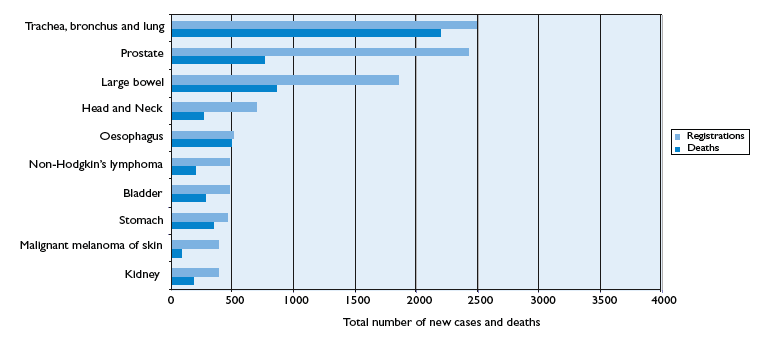
Figure 2: The most frequently diagnosed malignancies in women in Scotland in 2005
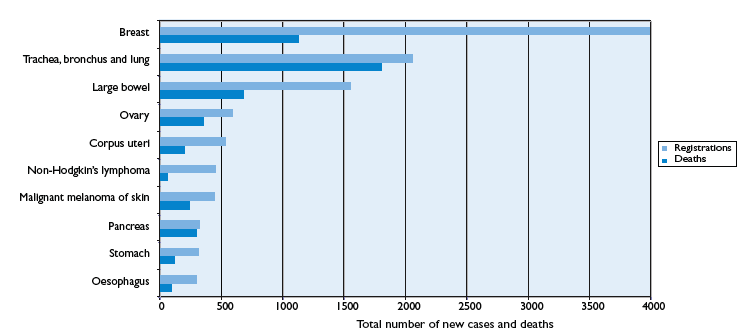
Figures 1 and 2 exclude non-melanoma skin cancers. Data Source: ISD
The total number of people diagnosed with cancer is increasing year on year, largely due to the increasing number of elderly people in the population and the fact that life expectancy is increasing. Cancer Scenarios published in 2001 and updated in 2004 and 2008 (2008 publication available on www.scotland.gov.uk/bettercancercare), sets out projections for the incidence of cancer as the basis for assessing and planning future cancer services in Scotland. Based on the trends observed between 1961 and 2000 and current population projections, Cancer Scenarios predicts that the number of cases diagnosed per annum is likely to rise to almost 35,000 in 2016-2020 (Table 1). Such projections may, of course, change if there are fundamental shifts in the size or age profile of Scotland's population or if further action is taken to encourage adoption of lifestyle changes that minimise risks.
Table 1: Projected number of new cases by cancer site
Cancer Site |
Projected new cases |
|||
|---|---|---|---|---|
2006-10 |
2011-15 |
2016-20 |
Difference in total (number) projected new cases between 2006-10 and 2016-20 |
|
Head and Neck |
5,986 |
6,377 |
6,796 |
810 |
Oesophagus |
5,032 |
5,739 |
6,641 |
1,609 |
Stomach |
4,140 |
4,013 |
3,846 |
-294 |
Large bowel |
20,388 |
22,783 |
25,579 |
5,191 |
Lung |
22,002 |
21,532 |
21,518 |
-484 |
Pancreas |
3,596 |
3,876 |
4,246 |
650 |
Malignant melanoma of the skin |
4,398 |
5,190 |
5,991 |
1,593 |
Breast |
20,841 |
22,331 |
24,431 |
3,590 |
Cervix |
1,378 |
1,211 |
1,041 |
-337 |
Corpus uteri |
2,523 |
2,755 |
3,024 |
501 |
Ovary |
3,764 |
4,090 |
4,420 |
656 |
Prostate |
11,803 |
13,864 |
16,034 |
4,231 |
Testis |
1,191 |
1,313 |
1,432 |
241 |
Renal |
3,636 |
4,196 |
4,870 |
1,234 |
Bladder* |
8,700 |
9,384 |
10,171 |
1,471 |
Brain, meninges and CNS |
1,976 |
2,122 |
2,298 |
322 |
Hodgkin's disease |
687 |
700 |
727 |
40 |
Non-Hodgkin's lymphoma |
5,517 |
6,384 |
7,378 |
1,861 |
Leukaemia |
3,656 |
4,042 |
4,488 |
832 |
Other and unspecified |
17,440 |
18,621 |
20,050 |
2,610 |
Total five-year period |
148,654 |
160,523 |
174,981 |
26,327 |
Average per annum |
29,731 |
32,105 |
34,996 |
5,265 |
* Includes carcinoma in situ and neoplasms of uncertain or unknown behaviour of the bladder. Data Source: ISD
Changes in the absolute numbers of cases of cancer are important in the context of health service planning, but they cannot be used on their own to predict the risk of developing cancer among the population. It is necessary to calculate age-standardised rates to assess how risk changes over time. Rates of breast and prostate cancer continue to increase, while rates of large bowel cancer have declined in recent years. Lung cancer rates have fallen amongst men and appear to be reaching a plateau for women (Figure 3).
Figure 3: Trends in European age-standardised incidence rates for large bowel, breast, lung and prostate cancer; Scotland: 1980-2005
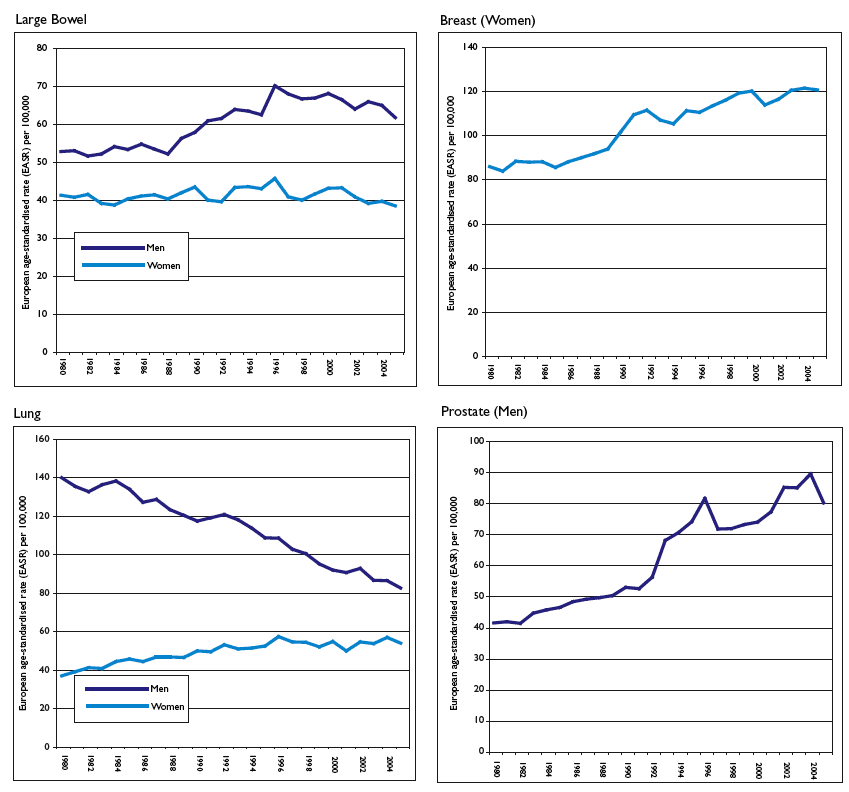
Age-standardised rates are adjusted to take account of changes in the age structure of the population over time.
Data Source: ISD
Cancer Incidence - Paediatrics and Young People
Every year, approximately 130 children aged 14 years and under are diagnosed with cancer in Scotland. This accounts for less than 1% of all cancers diagnosed at all ages. There has been a small, but statistically significant, increase in the incidence of childhood cancer from 108 per million children during 1975-1979 to 132 per million children during 1995-1999. The underlying cause of this increase is largely unexplained, although it continues to be the subject of ongoing research.
There are also 60 new cases of cancer each year in the 15-19 year age group. The most common types of cancer in this age group in Scotland are lymphomas and leukaemias. This is in contrast to younger children, where the relative frequency of different types of cancer is more evenly distributed.
Survival from Cancer
Survival is lowest in patients with cancers which often present at an advanced stage and are less amenable to treatment. These include cancers of the pancreas, lung and oesophagus. In men, survival at five years after diagnosis varies from under 5% for cancer of the pancreas, to over 95% for testicular cancer (Table 2). Equally, survival tends to be better for cancers where patients are more likely to present at an early stage. Examples include cancers of the uterus, bladder, thyroid, and malignant melanoma of the skin. Improved survival is also seen in cancers which can be detected early by screening programmes (such as, cancers of the cervix and breast) and for cancers where there have been major advances in treatment (such as, cancer of the testis and Hodgkin's disease).
Table 2: Five-year relative survival (%) for patients diagnosed in the period 2000-2004 ages 15-99: by cancer and gender
Cancer Site |
Men (%) |
Women (%) |
|---|---|---|
Oral cavity |
47.9 |
61.6 |
Head and Neck |
54.7 |
60.7 |
Oesophagus |
11.0 |
7.7 |
Stomach |
14.0 |
16.0 |
Large bowel |
54.9 |
53.9 |
Pancreas |
2.7 |
2.7 |
Larynx |
67.1 |
58.8 |
Trachea, bronchus and lung |
7.0 |
7.8 |
Malignant melanoma of the skin |
86.5 |
92.8 |
Breast (Women) |
83.7 |
|
Cervix uteri |
68.5 |
|
Corpus uteri |
82.9 |
|
Ovary |
38.1 |
|
Prostate |
80.1 |
|
Testis |
97.2 |
|
Bladder |
53.6 |
41.5 |
Kidney |
50.1 |
44.9 |
Brain and other CNS |
12.4 |
13.0 |
Thyroid |
80.8 |
91.5 |
Non-Hodgkin's lymphoma |
59.1 |
59.5 |
Hodgkin's disease |
89.0 |
91.9 |
Multiple myeloma |
33.9 |
32.0 |
Leukaemias |
53.0 |
50.0 |
All malignant neoplasms (excluding non-melanoma skin cancer) |
42.2 |
51.0 |
Data Source: ISD
Between 1980-84 and 2000-04, almost all cancers showed improvement in survival five years after diagnosis (Figure 4) and for some cancers this improvement was marked. For example, for malignant melanoma of the skin, survival increased from 62% in men diagnosed between 1980-84 to 87% during the period 2000-04, an absolute increase of 25%. This could be due, in part, to an increase in early stage diagnosis following health education programmes aimed at encouraging earlier presentation and referral.
Figure 4: Absolute difference a in relative survival at five years by cancer and gender: patients diagnosed in 2000-2004 compared to those diagnosed in 1980-1984 (patients aged 15-99)
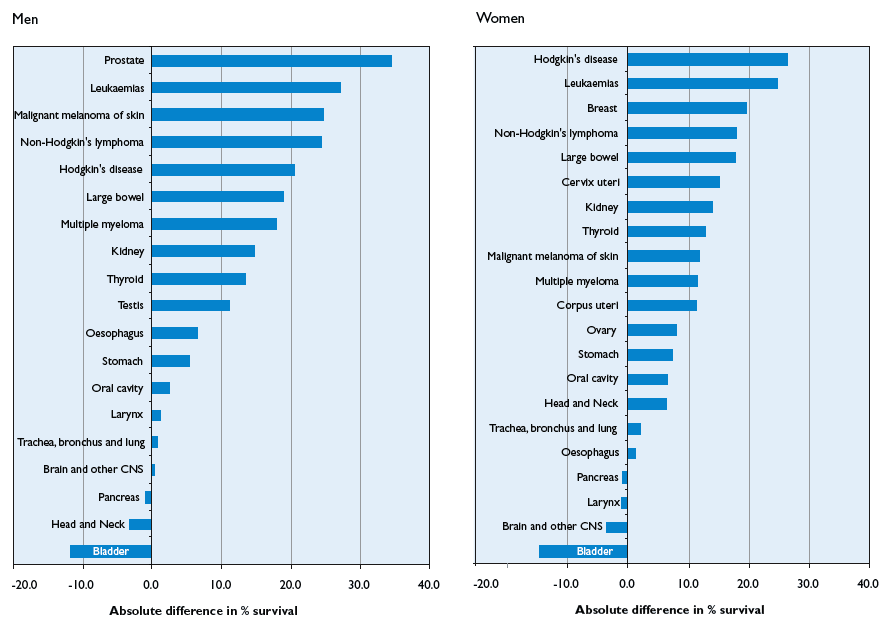
a The change over the whole period is calculated as the difference between relative survival at five years in 1980-84 and 2000-04.
Data Source: ISD
Other cancers with large absolute increases in survival at five years are large bowel cancer (up by 19% for men and 18% for women), Hodgkin's disease (up 20% for men and 27% for women), and leukaemia (up 27% for men and 25% for women). The increase in survival observed for prostate cancer in the most recent periods is likely to reflect the use of prostate-specific antigen ( PSA) testing. PSA testing may, however, result in misdiagnosis and result in the diagnosis of some less aggressive and possibly non life-threatening tumours (see prostate screening, page 37). The recent apparent decrease in survival from bladder cancer is a result of a change in disease classification and does not mean that fewer people are surviving in real terms.
Comparison with Other European Countries
Survival from cancer in Scotland is similar to that in England and in Wales, although survival from malignant melanoma of the skin is notably higher in Scotland. Scotland's survival from testis cancer is amongst the best in Europe, while survival for some cancers is lower compared with other European countries (Table 3).
Table 3: Five-year age-adjusted a relative b survival (%) for patients from selected European countries c diagnosed with selected cancers during 1995-1999
Country |
Site/type of cancer |
|||||||
|---|---|---|---|---|---|---|---|---|
Large bowel |
Lung |
Malignant melanoma of the skin |
Breast |
Ovary |
Prostate |
Testis |
Hodgkin's disease |
|
Scotland |
51.5 |
8.0 |
88.4 |
75.0 |
31.6 |
67.8 |
97.8 |
78.6 |
England |
50.8 |
8.6 |
84.6 |
77.6 |
30.3 |
69.8 |
95.6 |
79.1 |
N Ireland |
51.8 |
10.2 |
92.1 |
77.4 |
34.0 |
60.8 |
95.1 |
74.0 |
Wales |
50.6 |
9.0 |
73.6 |
76.9 |
32.3 |
68.7 |
93.3 |
75.4 |
Austria |
56.7 |
13.9 |
82.1 |
78.5 |
42.8 |
84.9 |
94.7 |
78.5 |
Denmark |
49.3 |
7.9 |
85.1 |
77.5 |
32.3 |
47.7 |
94.7 |
79.6 |
Finland |
57.8 |
9.6 |
84.5 |
83.6 |
39.6 |
80.0 |
94.9 |
83.6 |
Iceland |
57.3 |
14.7 |
83.9 |
87.6 |
30.5 |
79.8 |
N/A |
N/A |
Malta |
51.2 |
8.7 |
82.7 |
75.9 |
30.4 |
71.2 |
98.3 |
N/A |
Norway |
58.3 |
10.9 |
87.3 |
82.5 |
37.8 |
74.5 |
95.1 |
83.9 |
Slovenia |
44.2 |
8.8 |
79.6 |
71.9 |
33.4 |
58.2 |
95.2 |
82.5 |
Sweden |
58.3 |
13.1 |
90.2 |
84.3 |
42.2 |
77.3 |
97.7 |
83.1 |
Data Source: Eurocare
a To make comparisons more valid, survival estimates have been age-adjusted to allow for differences in the age structure of the populations of patients with cancer in different countries. Unadjusted estimates of survival may be higher or lower, depending on the cancer site/type.
b The calculation of relative survival takes account of differences in background mortality in different countries, therefore focusing on survival from cancer.
c Only countries with their total populations covered by cancer registration were selected.
Cancer Mortality
Over 15,000 people died of cancer in Scotland in 2007. Lung cancer accounted for the largest number of deaths in both sexes (29% in men, 25% in women). Large bowel, breast and prostate cancer were the other major causes of cancer deaths.
In the last decade, overall cancer mortality rates have decreased by 12% in men and 5% in women. In men, the largest falls in mortality from cancer have been in stomach, lung and large bowel cancer (29%, 22% and 19%). Death rates from prostate cancer, the second most frequently diagnosed cancer in men in 2005, decreased by 9%.
For women, the largest falls in mortality rates from cancer have been in stomach and large bowel cancer (37% and 17%, respectively). Death rates from breast cancer, the most frequently diagnosed cancer in women, have decreased by 12%, in spite of the increase in incidence of breast cancer in women. Cervical cancer deaths have also decreased by 32%.
Figure 5 shows the long-term observed and predicted trend in mortality by cancer site. It is predicted that, based on past and current mortality trends and projected changes in the population age structure, the number of cancer deaths will rise to around 17,000 per year in the period 2015-2019. Thus, although mortality rates have and should continue to decrease, the number of people in Scotland dying of cancer will increase as the population ages.
Figure 5: Observed and predicted cancer deaths by cancer site
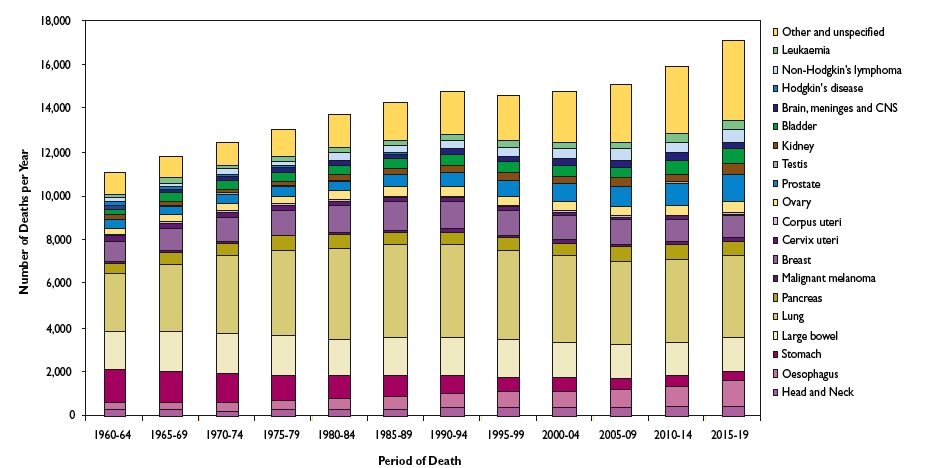
Data Source: ISD
Inequalities and Cancer
It is still the case that people living in the most deprived areas of Scotland have the highest risk of being diagnosed with cancer and the lowest chance of survival (Figure 6). Significant patterns exist when examining incidence and mortality rates by deprivation in Scotland. Considering all cancers combined, the most deprived areas report incidence rates almost 40% higher than the least deprived areas. Mortality rates for all cancers combined are approximately 75% higher in the most deprived compared to the least deprived areas. Only a few cancers have higher incidence rates in those living in the least deprived areas (for example, female breast cancer, prostate cancer and malignant melanoma of the skin).
Figure 6: All malignant neoplasms excluding non-melanoma skin cancer age-standardised incidence and mortality rates by SIMD (Scottish Index of Multiple Deprivation) 2006 deprivation quintile.
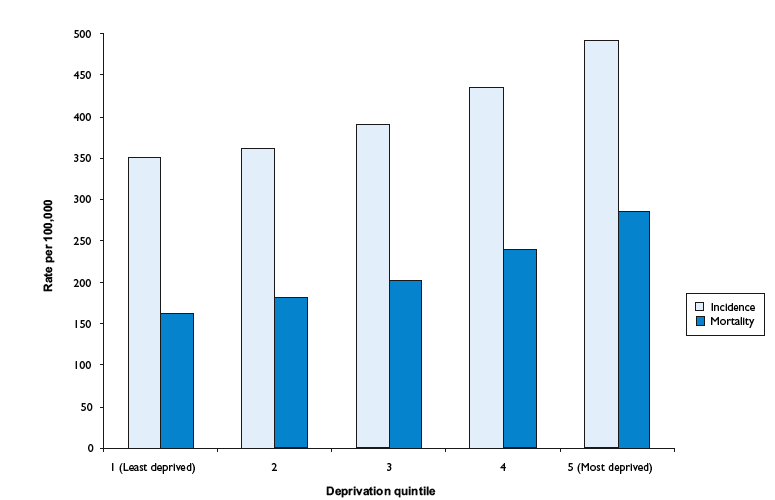
Source: Scottish Cancer Registry, ISD (incidence); General Register Office for Scotland ( GROS) (mortality and populations)
There is some evidence that socio-economic inequalities in survival are widening over time. This may indicate a lower awareness of the symptoms of cancer, the benefits of early detection through screening and differences in healthy lifestyle choices by people living in the most deprived areas. A report on long-term monitoring of health inequalities produced by the Scottish Government in response to recommendations from the Ministerial Task Force on Health Inequalities ( www.scotland.gov.uk/Publications/2008/09/25154901/0) presented analysis of inequalities in cancer mortality amongst those aged 45-74 years for the period 1997-2006. The results suggest that whilst inequalities appear to have been relatively stable in absolute terms, there has been a widening of inequalities in relative terms because improvements in the most deprived areas have not been as great as those observed in the least deprived areas.
There is a problem
Thanks for your feedback